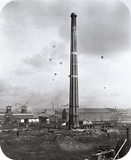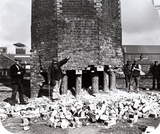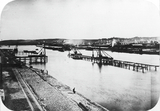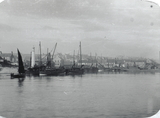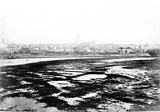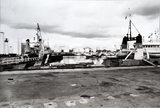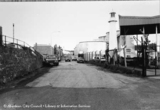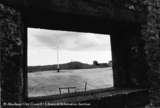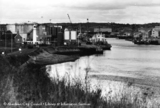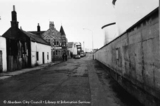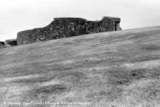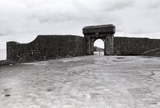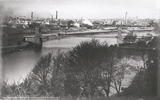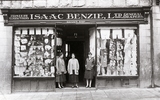|
Quick Search
|
Search Results
You searched for: Subject matches "Torry" or its children
95 items
items as
Diversion of the River Dee
157 The Dee originally flowed northward from Wellington Bridge close by the railway arches eastwards to the sea. After years of discussion about the development of the harbour, the Aberdeen Harbour Act of 1868 allowed the Harbour Commissioners to divert the river to the south. The first turf was cut by Lord Provost Leslie on 22nd December 1869.
This photograph shows the dam built to allow the excavation of the new channel. Most of the work was carried out by hand with men using picks and shovels. There was no official inauguration of the new channel but the river was following its new course by the beginning of 1873. Torry Brickworks chimney
309 A photograph showing the largest of the three substantial chimneys stalks that were located at the brick and tile works in Torry, located between Sinclair Road and Victoria Road.
This is one of three photographs on the Silver City Vault taken during the demolition of this Torry landmark on Saturday 12th September 1903. A full account of the demolition can be read in the Aberdeen Daily Journal from 14/09/1903, page 6.
The report tells us that the hexagonal stalk was 175 feet in height, consisted of 155,00 bricks and weighed 500 tons. The demolition was overseen by Mr Peter Tawse, a well known contractor.
Two years previously in 1901, the Seaton Brick and Tile Company had relocated their works from the site in Torry to Balgownie.
Seaton Brick and Tile Company was formed in 1884 after taking over the Northern Patent Brick and Tile Co., which operated a works at Seaton Links. They moved to the Torry works shortly afterwards.
The company continued operation at Balgownie until going into voluntary liquidation on Friday 1st August 1924. This was reported, with a short history of the company, in the next day's Press & Journal (page 6). Demolition of Torry Brickworks chimney
310 A photograph of the demolition of the largest of the chimney stalks at the Torry brick and tile works that took place on Saturday 12th September 1903.
The photograph illustrates the method employed to fall the 175 foot structure, by the overseer Peter Tawse, as described in the Press & Journal:
"The preliminary work of cutting a gap in the chimney near the base was early accomplished by three of the skilled tunnellers employed by Mr Tawse at the Girdleness outfall sewer. As the gap widened, stout wooden props were put in to support the structure. The gap was carried to more than half the circumference of the chimney, and the sight of the weighty pile supported on one side by only a half-dozen wooden props was certainty sufficient to make one nervous. The gang was under the charge of a Lancashire foreman, and they worked away, pipe in mouth, quite unconcernedly.
"The gap having been completed, a charge of dynamite was inserted at the bottom of the props, and a time fuse attached to each.
"Excitement reached a high pitch among the spectators when the signal was given to fire the fuses, and the crowd began to edge further away when the smoke was seen curling round the props, and as the workmen bolted to get beyond the danger zone. First one charge and then the other exploded with a sharp report, but it was not until the props at the extreme ends of the half circles were blown to splinters, that the chimney showed any sign of moving. It then came down, as a spectator remarked, - 'Jist like a rum'le o' bricks.' It slid rather than fell straight down at first, but the top portion toppled over in a south-easternly direction, exactly on the line expected by the contractor. It was all over in a couple of seconds, and certainly it was a sensational sight - so quick, so clear, so safe."
P&J, 14/09/1903, page 6. Demolition of Torry Brickworks chimney
311 Demolition of Torry Brickworks chimney. The factory was once a prominent feature of the Torry skyline. Diversion of the River Dee
323 A photograph in Aberdeen Harbour looking east from the Inches (near the later site of Commercial Road).
The image looks across the old course of the River Dee including its spillwater channel towards Old Torry and Balnagask in the distance.
The civil engineering works shown in this photograph are thought to be part of the river diversion, creation of Albert Basin and the associated reclamation of land.
The diversion of the River Dee took place roughly between 1868 and 1873. Old Torry
324 The prominent granite building in the centre of the image is the Torry Bar. It stands between the two leading lights.
A bucket dredger is shown on the right, while a number of scaffie fishing vessels are berthed on the Torry shore. Aberdeen Fisher Girls
398 These fishwivies are on the Torry side of River Dee and the photograph looks north west towards Tidal Harbour. Old channel of the River Dee
505 The old channel of the River Dee. After years of discussion about the development of the harbour, the Aberdeen Harbour Act of 1868 allowed the Harbour Commissioners to divert the river to the south. The first turf was cut by Lord Provost Leslie on 22nd December 1869. Maitland's Quay
608 A photograph looking north from Maitland's Quay, off Sinclair Road, into the River Dee Dock, also known as the Torry Dock.
Supply boats are moored in the dock and mud silos are visible on the left of the image, next to the site of John Lewis & Sons' shipyard.
Beyond the dock, across the River Dee, oil tanks can be seen on Point Law and the shipyard of Hall Russell can be seen in the far distance.
This image was likely taken in the 1980s. Torry
610 Looking west along Sinclair Road from where it meets Greyhope Road. The more easternly of the two leading lights is on the right.
Above the wall on the left of the image is the location of Campbell's Bar. It closed down on 28th August 2016. Public houses had operated on the site, under various names, since the 1860s. It was noted for its excellent views of the harbour mouth.
This photograph likely dates from the 1980s. Torry Battery
611 The Torry Battery was built in 1860 to withstand a French invasion that never materialised. It was also part of the World War 2 defences to repel the Nazi invasion that never came, although guns there did fire at enemy planes.For a short time in the 1950's it was used for housing. It became an unofficial dumping ground and eyesore until it was given a facelift in 1971. It is now listed as a Scheduled Ancient Monument. Torry Battery
612 The Torry Battery was built in 1860 to withstand a French invasion that never materialised. It was also part of the World War 2 defences to repel the Nazi invasion that never came, although guns there did fire at enemy planes.For a short time in the 1950's it was used for housing. It became an unofficial dumping ground and eyesore until it was given a facelift in 1971. It is now listed as a Scheduled Ancient Monument Maitland's Quay
613 A photograph looking north east from Maitland's Quay, off Sinclair Road, into the River Dee Dock, also known as the Torry Dock.
Supply boats are moored in the dock and mud silos are visible on the left of the image, next to the site of John Lewis & Sons' shipyard.
Beyond the dock, across the River Dee, oil tanks can be seen on Point Law.
This image was likely taken in the 1980s. Torry
614 An 1980s photograph looking west towards Torry Harbour, Sinclair Road and the River Dee channel from a grassy area off Greyhope Road.
Campbell's Bar and the more easternly leading light can be seen. Torry Battery
618 The Torry Battery was built in 1860 to withstand a French invasion that never materialised. It was also part of the World War 2 defences to repel the Nazi invasion that never came, although guns there did fire at enemy planes.For a short time in the 1950's it was used for housing. It became an unofficial dumping ground and eyesore until it was given a facelift in 1971. It is now listed as a Scheduled Ancient Monument. Torry Battery
620 The Torry Battery was built in 1860 to withstand a French invasion that never materialised. It was also part of the World War 2 defences to repel the Nazi invasion that never came, although guns there did fire at enemy planes. For a short time in the 1950's it was used for housing. It became an unofficial dumping ground and eyesore until it was given a facelift in 1971. It is now listed as a Scheduled Ancient Monument Torry Battery
624 The Torry Battery was built in 1860 to withstand a French invasion that never materialised. It was also part of the World War 2 defences to repel the Nazi invasion that never came, although guns there did fire at enemy planes. For a short time in the 1950's it was used for housing. It became an unofficial dumping ground and eyesore until it was given a facelift in 1971. It is now listed as a Scheduled Ancient Monument The Harbour Mouth, Aberdeen
657 A George Washington Wilson photograph titled The Harbour Mouth, Aberdeen and numbered 505.
The image looks north east from the fields above Old Torry. Point Law, dividing the River Dee channel and the Tidal Harbour, is largely undevelopment. It looks like construction work may be going on over the water at Pocra Quay.
Correspondent Ed Fowler suggests that the large temporary looking building that can be seen across the water, past the round house on the New Quay, is of particular interest. He posits it was used to cast concrete blocks for an extension to the North Pier between 1869-77. Wellington Suspension Bridge
1073 The Wellington Suspension Bridge (also known as the Chain Bridge) over the River Dee at Torry. Isaac Benzie's shop, Torry
1104 Isaac Benzie's shop on Victoria Road, Torry. Benzie is better known as being on George Street, or perhaps Union Street, but he also had a branch shop on Victoria Road. This indicates what an important part of town Torry was becoming after the late 19th century. Aberdeen Fire Brigade (Torry Branch)
1213 Aberdeen Fire Brigade (Torry Branch). This was a voluntary service. Robert Fergus Abercrombie (Second from left) was firemaster. c.1940.
Local historian, Ed Fowler, has been in touch to suggest this image shows the part-time firemen of the Torry Auxiliary Fire Station. Ed states the station was based in Cordiner's Garage on Menzies road and was one of nine set-up around Aberdeen in 1939, just prior to the outbreak of WW2.
The firemaster in this image is sitting on one of the trailer pumps that was issued to the auxiliary stations. |




